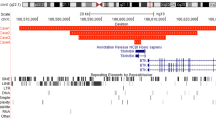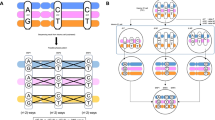Abstract
Nijmegen breakage syndrome (NBS), also known as ataxia-telangiectasia (AT) variant, is an autosomal recessive disorder characterized by microcephaly, growth retardation, severe combined immunodeficiency and a high incidence of lymphoid cancers. Cells from NBS patients display chromosome instability, hypersensitivity to ionizing radiation and abnormal cell-cycle regulation after irradiation, all of which are characteristics shared with AT. Recently, the NBS locus was mapped at 8q21 by two independent approaches, complementation studies1 and linkage analysis2. Here, we report the positional cloning of the NBS gene, NBS1, from an 800-kb candidate region. The gene comprises 50 kb and encodes a protein of 754 amino acids. The amino-terminal region of the protein shows weak homology to the yeast XRS2, MEK1, CDS1 and SPK1 proteins. The gene is expressed at high levels in the testes, suggesting that it might be involved in meiotic recombination. We detected the same 5-bp deletion in 13 individuals, and conclude that it is likely to be a founder mutation.
This is a preview of subscription content, access via your institution
Access options
Subscribe to this journal
Receive 12 print issues and online access
$209.00 per year
only $17.42 per issue
Buy this article
- Purchase on Springer Link
- Instant access to full article PDF
Prices may be subject to local taxes which are calculated during checkout




Similar content being viewed by others
Accession codes
References
Matsuura, S. et al. Genetic mapping using microcell-mediated chromosome transfer suggests a locus for Nijmegen breakage syndrome at chromosome 8q21-24. Am. J. Hum. Genet. 60, 1487–1494 ( 1997).
Saar, K. et al. The gene for the ataxia-telangiectasia variant, Nijmegen breakage syndrome, maps to a 1-cM interval on chromosome 8q21. Am. J. Hum. Genet. 60, 605–610 ( 1997).
Burge, C. Karlin, S. Prediction of complete gene structures in human genomic DNA. J. Mol. Biol. 268, 78 –94 (1997).
Xu, Y. Mural, R. Shah, M. Uberbacher, E. Recognizing exons in genomic sequence using GRAIL II. in Genetic Engineering: Principles and Methods (ed. Setlow, J.) 241–253 (Plenum, New York, 1994).
Altschul, S. et al. Gapped BLAST and PSI-BLAST: a new generation of protein database search programs . Nucleic Acids Res. 25, 3389–3402 (1997).
Parmentier, M. Lawson, D.E. Vassart, G. Human 27-kDa calbindin complementary DNA sequence.Evolutionary and functional implications. Eur. J. Biochem. 30, 207–215 (1987).
Helander, H.M. et al. Molecular cloning and characterization of the human mitochondrial 2,4-dienoyl-CoA reductase gene (DECR). Genomics 46, 112–119 (1997).
Solovyev, V.V. Salamov, A.A. Lawrence, C.B. The prediction of human exons by oligonucleotide composition and discriminant analysis of spliceable open reading frames. in The Second International conference on Intelligent systems for Molecular Biology (eds Altman, R., Brutlag, D., Karp, R., Latrop, R. & Searls D.) 354–362 (AAAI Press, Menlo Park, 1994).
Jaspers, N.G.J. Taalman, R.D.F.M. Baan, C. Patients with inherited syndrome characterized by immunodeficiency, microcephaly, and chromosomal instability: genetic relationship to ataxia telangiectasia. Am. J. Hum. Genet. 42, 66 –73 (1988).
Jongmans, W. et al. Nijmegen breakage syndrome cells fail to induce the p53-mediated DNA damage response following exposure to ionizing radiation. Mol. Cell. Biol. 17, 5016–5022 ( 1997).
Matsuura, K. et al. Radiation induction of p53 in cells from Nijmegen breakage syndrome is defective but not similar to ataxia-telangiectasia. Biochem. Biophys. Res. Commun. 242, 602–607 ( 1998).
Nakai, K. Kanehisa, M. A knowledge base for predicting protein localization sites in eukaryotic cells. Genomics 14 , 897–911 (1992).
Pearson, W.R. Lipman, D.J. Imported tools for biological sequence comparison. Proc. Natl. Acad. Sci. USA 85, 2444–2448 (1988).
Ivanov, E.L. Sugawara, N. White, C.I. Fabre, F. Haber, J.E. Mutations in XRS2 and RAD50 delay but do not prevent mating-type switching in Saccharomyces cerevisiae. Mol. Cell. Biol. 14, 3414–3425 ( 1994).
Rockmill, B. Roeder, G.S. A meiosis-specific protein kinase homolog required for chromosome synapsis and recombination. Genes Dev. 5, 2392–2404 ( 1991).
Murakami, H. Okayama, H. A kinase from fission yeast responsible for blocking mitosis in S phase. Nature 374, 817–819 (1995).
Allen, J.B. Zhou, Z. Siede, W. Friedberg, E.C. Elledge, S.J. The SAD1/RAD53 protein kinase controls multiple checkpoints and DNA damage-induced transcription in yeast. Genes Dev. 8, 2401–2415 (1994).
Shilo, Y. Ataxia-telangiectasia and the Nijmegen breakage syndrome: related disorders but genes apart. Annu. Rev. Genet. 31, 635–662 (1997).
Keegan, K.S. et al. The Atr and Atm protein kinases associated with different sites along meiotically pairing chromosomes. Genes Dev. 10, 2423 –2437 (1996).
Weemaes, C.M.R. Hustinx, T.W.J. van Munster, P.J.J. Bakkeren, J.A.J.M. Taalman, R.D.F.M. A new chromosomal instability disorder; the Nijmegen breakage syndrome. Acta. Paediatr. Scand. 70, 557–564 ( 1981).
van der Burgt, I. Chrzanowska, K.H. Smeets, D. Weemaes, C. Nijmegen breakage syndrome. J. Med. Genet. 33, 153 –156 (1996).
Sambrook, J. Fritsch, E.F. Maniatis, T. Molecular Cloning: A Laboratory Manual (Cold Spring Harbor Laboratory Press, Cold Spring Harbor, 1989).
Acknowledgements
The authors would like to thank C. Weemaes, K. Sperling, K.H. Chrzanowska, the patients and their families for collection of NBS samples, H. Nanba for collection of control samples, and N. Niikawa, Y. Jinno, H. Tomita, Y. Furuichi, J. Nakura, T. Kajii and K. Miyagawa for helpful discussions. The authors also thank T. Jo, S. Kunisada, M. Ueda, A. Kodama, K. Takeuchi, Y. Yamane and M. Kobayashi for laboratory assistance. This work was supported by the Ministry of Education, Science and Culture of Japan.
Author information
Authors and Affiliations
Corresponding author
Rights and permissions
About this article
Cite this article
Matsuura, S., Tauchi, H., Nakamura, A. et al. Positional cloning of the gene for Nijmegen breakage syndrome. Nat Genet 19, 179–181 (1998). https://doi.org/10.1038/549
Received:
Accepted:
Issue Date:
DOI: https://doi.org/10.1038/549
This article is cited by
-
Chromosome instability syndromes
Nature Reviews Disease Primers (2019)
-
Pellino1 regulates reversible ATM activation via NBS1 ubiquitination at DNA double-strand breaks
Nature Communications (2019)
-
NBS1 interacts with HP1 to ensure genome integrity
Cell Death & Disease (2019)
-
Combinations of chromosome transfer and genome editing for the development of cell/animal models of human disease and humanized animal models
Journal of Human Genetics (2018)
-
Genome instability syndromes caused by impaired DNA repair and aberrant DNA damage responses
Cell Biology and Toxicology (2018)



